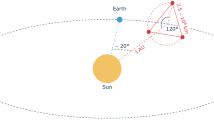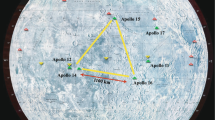Abstract
The scientific objective of the Lunar-A, Japanese Penetrator Mission, is to explore the lunar interior by seismic and heat-flow experiments. Two penetrators containing two seismometers (horizontal and vertical components) and heat-flow probes will be deployed from a spacecraft onto the lunar surface, one on the near-side and the other on the far-side of the moon. The data obtained by the penetrators will be transmitted to the earth station via the Lunar-A mother spacecraft orbiting at an altitude of about 200 km.
The spacecraft of a cylindrical shape, 2.2 m in maximum diameter and 1.7 m in height, is designed to be spin-stabilized. The spacecraft will be inserted into an elliptic lunar orbit, after about a half-year cruise during which complex manoeuvering is made using the lunar-solar gravity assist. After lunar orbit insertion, two penetrators will be separated from the spacecraft near perilune, one by one, and will be landed on the lunar surface.
The final impact velocity of the penetrator will be about 285 m/sec; it will encounter a shock of about 8000 G at impact on the lunar surface. According to numerous experimental impact tests using model penetrators and a lunar-regolith analog target, each penetrator is predicted to penetrate to a depth between l and 3 m, depending on the hardness and/or particle-size distribution of the lunar regolith. The penetration depth is important for ensuring the temperature stability of the instruments in the penetrator and heat flow measurements. According to the results of the Apollo heat flow experiment, an insulating regolith blanket of only 30 cm is sufficient to dampen out about 280 K lunar surface temperature fluctuation to < 3 K variation.
The seismic observations are expected to provide key data on the size of the lunar core, as well as data on deep lunar mantle structure. The heat flow measurements at two penetrator-landing sites will also provide important data on the thermal structure and bulk concentrations of heat-generating elements in the Moon. These data will provide much stronger geophysical constraints on the origin and evolution of the Moon than has been obtained so far.
Currently, the Lunar-A system is being reviewed and a more robust system for communication between the penetrators and spacecraft is being implemented according to the lessons learned from Beagle-2 and DS-2 failures. More impact tests for penetrators onto a lunar regolith analogue target will be undertaken before its launch.
Similar content being viewed by others
References
Carrier W D III, Olhoel G R and Mendell W 1991 Physical Properties of the Lunar Surface in Lunar Source Book; A Users Guide Book (eds) G Heiken, D Vaniman and B M French (London: Cambridge University Press) pp. 475–594.
Chenet H, Gagnepain-Beyneix J P, Lognonne P and Vinnik L 2000 Reprocessing of the Apollo lunar seismic data: A thinner lunar crust; EOS Transaction AGU 8l F771.
Goins N R, Dainty A M and Toksoz M N 1981 Lunar seismology: The internal structure of the moon,J. Geophys. Res. 86 5061–5074.
ISAS Lunar Penetrator Team 1993 Report of the 13th penetrator impact experiment in Japanese SES-TD-93-004;Inst. Space Astronaut Sci., p. 239.
Jolliff B L, Gillis J I, Haskin L A, Korotev R L and Wieczorek M A 2000 Major lunar crustal terranes: Surface expressions and crust-mantle origins;J. Geophys. Res. 109 4197–4216.
Keihm S J and Langseth M G 1977 Lunar thermal regime to 300 km;Proc. Lunar Sci. Conf. 8th, pp. 499–514.
Khan A, Mosegaard K and Rasmussen K L 2000 A new seismic velocity model for the Moon from a Monte Carlo inversion of the Apollo seismic data;Geophys. Res. Lett. 27 1592–1594.
Kuskov O L 1995 Constitution of the Moon: 3 Composition of middle mantle from seismic data;Phys. Earth Planet. Int. 90 55–74.
Kuskov O L 1995 Constitution of the Moon: 3 Composition of middle mantle from seismic data;Phys. Earth Planet.Int. 90 55–74.
Kuskov O L and Kronrad V A 1998 Constitution of the Moon: 5 Constraints on composition density temperature and radius of a core;Phys. Earth Planet. Int. 107 285–306.
Langseth M G, Keihm S J and Peters K 1976 Revised lunar heat flow values;Proc. Lunar Sci. Conf. 7th, pp. 3143–3171.
Latham V L, Ewing M, Press F, Sutton G, Dorman J, Toksoz N, Wiggins R, Nakamura Y, Derr J and Duennebier F 1969 Passive seismic experiment Apollo ll; Preliminary Report NASA SP-214, pp. 143–161.
Lawrence D J, Feldman W C, Barraclough B L, Binder A B, Elphic R C, Maurice S, Miller M C and Prettyman T H 1999 High resolution measurements of absolute thorium abundance on the lunar surface;Geophys. Res. Lett. 26 268l-2684.
Mizutani H, Fujimura A, Tanaka S, Shiraishi H and Nakajima T 2003 Lunar-A mission: Goals and Status;Adv. Sci. Res. 31 2315–2321.
Nakamura Y 1983 Seismic velocity structure of the lunar mantle;J. Geophys. Res. 88 677–686.
Nakamura Y, Latham G Vand Dorman H J 1982 Apollo lunar seismic experiment — final summary; Proc. Lunar Planet Sci. Conf. l3thJ. Geophys. Res. 87 A117-A123.
Newsome H E and Drake M J 1983 Experimental inves- tigation of the partitioning of phosphorous between metal and silicate phases: Implication for the earth, moon and eucrite body;Geochim. Cosmochim. Acta 47 93–100.
Newsome H E 1986 Constraints on the origin of the Moon from the abundance of molybdenum and other siderophile elements; In:The Origin of the Moon (eds) Hrtmann W K, Phillips R J and Taylor G J (Houston: Lunar and Planetary Institute) pp. 203–230.
Pieters C M, Staid M I, Fischer S and Tomplins G H 1994 A sharper view of impact craters from Clementine data;Science 266 1844–1850.
Rasmussen K L and Warren P H1985 Magaregolith thickness, heat flow and the bulk composition of the moon;Nature 313 121–124.
Ringwood A E and Seifert S 1986 Nickel-Cobalt abundance systematics and their bearing on lunar origin; In:The Origin of the Moon (eds) W K Hartmann, R J Phillips and G J Taylor (Houston: Lunar and Planetary Institute) pp. 249–278.
Tanaka S, Yoshida S, Hayakawa M, Horai K, Fujimura A and Mizutani H 1999 Development of the heat flow measurement system by Lunar-A penetrators;Adv. Space. Res. 23 1825–1828.
Toksoz M, Dainty N A M, Solomon S CandAnderson K 1974 Structure of the Moon;Rev. Geophys. Space Phys. 12 539–567.
Uesugi K, Kawaguchi J, Ishii S, Kimura M and Tanaka K 1989 Design of double lunar swing by orbits for MUSESA and Geotail;Advance Astron. Sci. 69 319–331.
Wood J A 1986 Moon over Mauna Loa: A review of hypotheses of formation of Earth’s Moon; In:The Origin of the Moon (eds) W K Hartmann, R J Phillips and G J Taylor (Houston Lunar and Planetary Institute) pp. 17–56.
Author information
Authors and Affiliations
Rights and permissions
About this article
Cite this article
Mizutani, H., Fujimura, A., Tanaka, S. et al. Lunar-A mission: Outline and current status. J Earth Syst Sci 114, 763–768 (2005). https://doi.org/10.1007/BF02715961
Issue Date:
DOI: https://doi.org/10.1007/BF02715961




